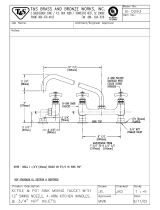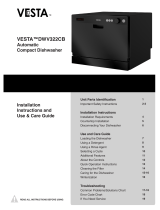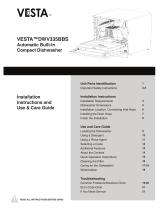
iii
Table of Contents
IMPORTANT SAFETY INFORMATION ..............................................................................I
PRECAUTIONS FOR OPERATION ....................................................................................II
INTRODUCTION ............................................................................................................. 1
PARTS IDENTIFICATION ................................................................................................. 2
FRONT VIEW ...................................................................................................................... 2
BACK VIEW ........................................................................................................................ 2
ACCESSORIES ..................................................................................................................... 2
PREPARING THE DISHWASHER FOR USE ........................................................................ 3
UNPACKING THE DISHWASHER .............................................................................................. 3
INSTALLATION REQUIREMENTS ..................................................................................... 3
CLEARANCE REQUIREMENTS ................................................................................................. 3
WATER REQUIREMENTS ....................................................................................................... 3
Water Pressure.......................................................................................................... 3
Water Temperature .................................................................................................. 3
ELECTRICAL REQUIREMENTS .................................................................................................. 3
CONNECTING THE HOSES TO THE DISHWASHER ............................................................ 4
DISCONNECTING YOUR DISHWASHER ...................................................................................... 5
OPERATING INSTRUCTIONS ........................................................................................... 6
CHECKLIST BEFORE USING YOUR DISHWASHER .......................................................................... 6
CONTROL PANEL FUNCTIONS ................................................................................................ 6
Error Codes ................................................................................................................ 6
WASH CYCLES CHART .......................................................................................................... 7
PROPERLY LOADING THE DISHWASHER .................................................................................... 8
Cutlery Basket ........................................................................................................... 9
ONLY USE PROPER DETERGENT ............................................................................................. 9
USE JET-DRY RINSE AGENT ................................................................................................. 11
STARTING THE WASH CYCLE ............................................................................................... 12
CHANGING THE CYCLE ....................................................................................................... 12
Forget to Add a Dish? .............................................................................................. 13
AT THE END OF THE WASH CYCLE ........................................................................................ 13
MAINTENANCE ............................................................................................................ 14
FILTER SYSTEM ................................................................................................................. 14
CLEANING THE DISHWASHER ...................................................................................... 15
CLEANING THE DOOR ........................................................................................................ 15
CLEANING THE SPRAY ARMS ............................................................................................... 15
PROTECT AGAINST FREEZING ...................................................................................... 15
GUIDE TO KEEPING THE DISHWASHER IN TOP SHAPE.................................................. 16
TROUBLESHOOTING .................................................................................................... 17
TROUBLESHOOTING CONTINUED .......................................................................................... 18
SPECIFICATIONS .......................................................................................................... 19
EDGESTAR LIMITED WARRANTY .................................................................................. 20























